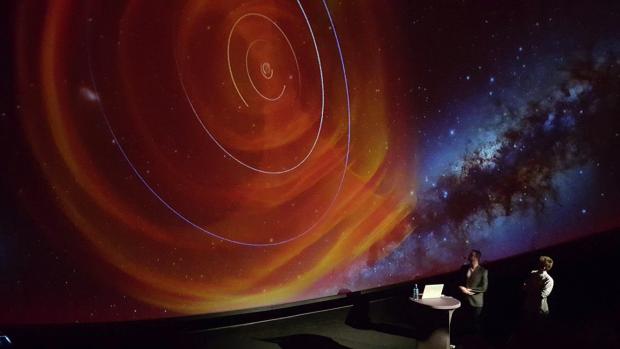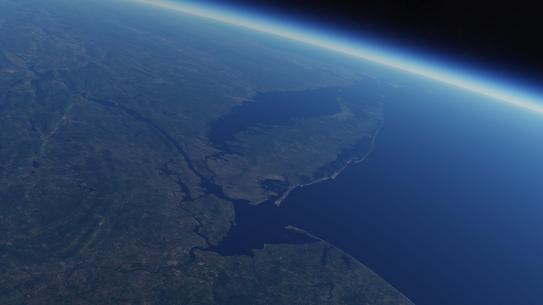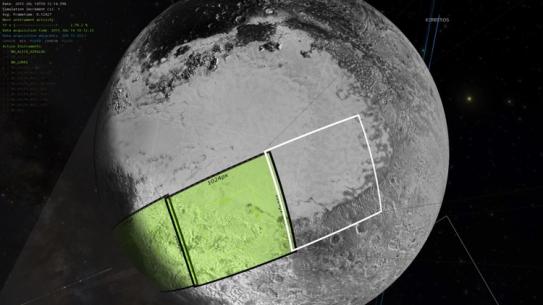With NYU Tandon’s help, the American Museum of Natural History relaunches Apollo 11

A presentation on space "weather" within our solar system at AMNH
Who says you need to board a rocket to visit space? OpenSpace, a NASA-funded open-source visualization tool for astrographics that researchers at NYU Tandon are helping to develop, lets people visit the planets, voyage to the far reaches of the solar system, and venture to the ends of the universe either at a planetarium or using just their laptop.
OpenSpace is a collaborative project that includes Claudio Silva, professor of computer science and engineering at NYU Tandon and director of the Visualization and Data Analytics Center (ViDA) Lab; and Jonathas Campi Costa, research associate at the ViDA Lab (project manager/ principal investigator, and software developer on the project, respectively).
The American Museum of Natural History (AMNH) will deploy the platform on Saturday, July 20 for two presentations open to the public commemorating the 50th anniversary of the Apollo 11 mission. For one of them, AMNH Director of Astrovisualization Carter Emmart, a long-time collaborator and principal investigator on the OpenSpace project, will take attendees on the historic 1969 mission to the moon using OpenSpace to build 3D trajectories and insert animated visual content to show the audience what the journey entailed.
The other, a presentation on heliophysics by the National Science Foundation-funded Community Coordinated Modeling Center (CCMC) group at NASA Goddard, will be live broadcast to the Adler Planetarium, in Chicago, and California Academy of Sciences, in San Francisco.
OpenSpace began as a visualization research project of former NYU Tandon post-doctoral research fellow Alexander Bock while a Ph.D. student at Sweden’s Linköping University (LiU). Encouraged by Emmart and one of his supervisors, Prof. Anders Ynnerman, he made the project capable of being deployed for public presentations.
In 2017 Bock, also OpenSpace’s lead developer, came to NYU Tandon to continue his work on on the project with Silva. By that time the project had received financial support with a NASA Cooperative Agreement Notice grant of $6.3 million that allowed the ViDA Lab and other collaborators to hire research engineers, including — at NYU Tandon — Campi Costa.

Over the years collaborators on OpenSpace have generated more than two dozen academic papers, including, most recently, “OpenSpace: A System for Astrographics,” by Bock, Campi Costa, Silva, and others, to be published in the Proceedings of IEEE SciVis, as part of the team’s presentation at VIS 2019 in Vancouver, October 20-25, 2019.
Campi Costa said that until 2016, OpenSpace was used for certain visualizations limited to the solar system or very specific extra-solar cases, with no support for digital atlases. But because contributors have access to NASA’s publicly available data, it has expanded its view (literally) using NASA satellite imagery and geo-mapping, data from onboard sensors, and surface images captured by the Mars rovers and other probes. A recent addition was the AMNH’s digital atlas, called the Digital Universe.
“One can roam the surface of our planet or Mars, or voyage several lightyears from our solar system and, by filtering datasets of our cosmic neighborhood, view the over 3,000 exoplanetary systems discovered so far,” he said, adding that the AMNH has created OpenSpace “scenes” (visualizations using multiple data sets) recreating such adventures as the European Space Agency’s Venus Express and Rosetta missions and NASA’s Juno, Deep Impact, Dawn, Osiris-Rex, MAVEN, and New Horizons missions.
NYU Tandon’s role is to help create rich graphics from NASA data, with Campi Costa focused on creating realistic, state-of-the-art graphical visualizations, for example the visualization of atmospheric models for different planets, stars, and other bodies. On Mars, for example, as an OpenSpace user descends toward the planet’s surface, the sky takes on a yellow tinge that replicates atmospheric effects from on-board lander cameras (based on atmospheric physics) as the human eye would perceive them, as well as blue sunsets based on rover surface data.
“Visualizations of galaxies, quasars, exoplanets, microwave background radiation, and much more are available now on OpenSpace,” said Campi Costa. “One of the later datasets is the European Space Agency’s (ESA) data from the Gaia mission [launched in 2013 to chart a three-dimensional map of our galaxy], and because of that we now have a much richer map of the stars.”

The next project with AMNH will be an interactive exhibit about the Curiosity rover mission to Mars, where an animated version of the rover roams landscapes built with NASA surface images. “We have the images already but now we must create the animation, visualizing the correct orientation and events in the mission,” said Campi Costa. “The goal is to create images that are most relevant to scientists, educators, and audiences.”
To date, there have been some 360,000 individual engagements on the platform, including 326,000 museum visitors, more than 230 teachers and educators, and some 33,700 youth.
Although OpenSpace shows in planetariums deliver the big audiences, Bock explained that anyone can use it, or contribute or retrieve data for OpenSpace from GitHub. “In fact, two years ago we organized an OpenSpace ‘hackathon,’ and in two days, with the tools we had, we were able to use donated data to create a visualization of the Cassini probe and Messenger missions. So, really, anyone can go to the web page and download these freely available models.”
Silva said users don’t have to own a massively powerful computer to run visualizations. “OpenSpace works on multiple operating systems, with a flexible, extensible architecture that makes work on everything from laptop screens to planetarium domes,” he said. “It employs tiled displays and cutting-edge graphic card technologies, and is also capable of making simultaneous connections across the globe, creating opportunities for shared experiences among audiences worldwide.”
In fact, in 2015 an interactive OpenSpace exhibit at AMNH on the New Horizons mission was “domecast” to more than a dozen planetariums around the world. Among the 17 planetariums and institutes using OpenSpace are the Fiske Planetarium at the University of Colorado, Boulder; Planetarium Sudtirol, the City College of New York Planetarium, the Natural History Museum of Vienna, Singapore Science Center, the Ghana Planetarium, and Hamburg Planetarium.
Besides NYU Tandon, OpenSpace collaborators include the University of Utah’s Scientific Computing and Imaging (SCI) Institute, the Denver Museum of Nature & Science, Adler Planetarium, Houston Museum of Natural Science, California Academy of Sciences, and the North Carolina Museum of Natural Science. New members include the Knut and Alice Wallenberg Foundation, Vetenskapsrådet (the Swedish version of NSF), and the Swedish e-Science Research Centre.
Campi Costa said the goal is not just making OpenSpace the next great thing for planetariums, but to make it available as a free teaching, visualization, and research tool. “People use it to do live presentations, but because it is an interactive, flexible system, it’s ideal for scientific visualization and teaching: one can stop, start, review, and alter how it looks, and the data it represents if, for example, students have questions, or one wishes to clarify a point. It’s just a wonderful tool to spark an interest in astronomy in kids.”
Mission Possible
OpenSource allows us to visualize the entire known universe. Watch this trip from Vandenberg, CA to Cape Canaveral, FL and then off to Valles Marineris, Mars.
View additional visualizations that are possible with the OpenSpace software:


